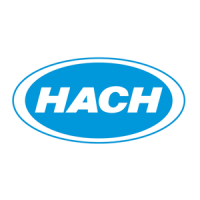31
Section 8 Cyanide–1
8.1 Micro Dist™ Method (Method Number 10-204-00-1-X)
DANGER
Chemical inhalation hazard. To avoid potential exposure to cyanide gas (HCN), the
manufacturer recommends operating the Micro Dist under a fume hood.
DANGER
Risque d'inhalation de produits chimiques. Pour éviter le contact potentiel avec du gaz de
Cyanure d'hydrogène (HCN), le fabricant recommande d'utiliser le Micro Dist sous une
hotte aspirante.
CAUTION
Chemical hazard. Always follow appropriate laboratory safety procedures when handling
chemicals. Always wear personal protective equipment appropriate for the chemicals you
are handling.
ATTENTION
Danger chimique. Suivez toujours les procédures de laboratoire de sécurité lors de
l'utilisation de produits chimiques. Veuillez toujours porter l'équipement de protection
personnel approprié pour les produits chimiques que vous manipulez.
This is a method for distilling samples containing 0.002 to 100 mg Free and Combined Cyanide/L
with the Micro Dist distillation apparatus.
In the following procedure,
D and M refer to the marks on the ends of the collector tube. D means
'distillation' or 'discarded' end and
M means 'measuring' end. See Figure 2 on page 13.
1. Set the controller to 120 °C. Allow the heater block to warm up. This will take about
40 minutes.
2. With the
M end up, put the required number of collector tubes into the collector tube rack.
When using the Pre-filled collector tubes, re-seal the foil pack after removing the tubes if there
are any left. When using the User-Fill collector tubes, fill and cap the tubes before using.
3. Put the required number of sample tubes into the sample tube rack; up to 21 for one block.
Place 6.0 mL of sample (or standard) into each sample tube with an automatic pipet.
4. Add between 0.5 to 1.0 g of soil or sludge to 5 mL of DI water. The amount of cyanide in the
soil or sludge in 6 mL should be between about 0.012 and 600 µg. If the sample is high in
organics, a smaller sample size or less DI water may be required. Foaming or caking of the
membrane is often eliminated by the above measures. If not, see Running Solid Samples with
Micro Dist on page 70.
5. In this method, it is imperative that the standards be distilled with the samples.
6. In order to both release the free cyanide as HCN and to digest complexed cyanides during the
digestion/distillation, first prime the re-pipettor several times into a waste container. Then, add
0.75 mL of 7.11 M sulfuric acid / 0.79 M magnesium chloride solution to the sample tube using
the supplied automatic pipet.
7. Immediately push the
D end of a Cyanide–1 collector tube over the open end of each sample
tube to start the seal.
8. Place the assembly in the press, putting the sample tube through the hole in the white base.
Before pressing the user should grip the collector tube firmly at the breakaway point to keep
the tube from shifting during the pressing procedure.
9. The pressing motion should be a smooth constant pressure which is just enough to slide the
sample tube inside the collector tube. A jerky, forced motion may cause added strain to the
tube and could potentially crack it. Press down on the handle until the stop ring on the sample
tube hits the
D end of the collector tube.

